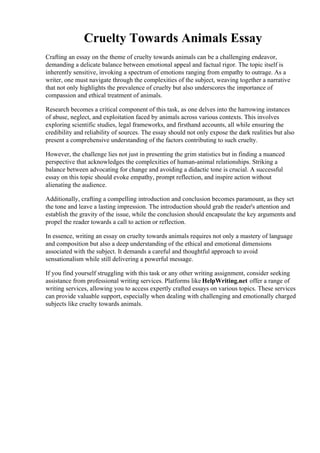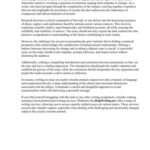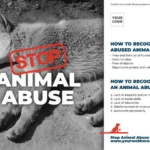Animal cruelty is an appalling reality that plagues societies worldwide. It manifests in various forms, from neglect and abandonment to direct abuse. This essay aims to illuminate powerful ideas for advocacy that can be utilized to prevent animal cruelty effectively.
First and foremost, it is imperative to understand the roots of animal cruelty. A historical lens reveals that societal attitudes towards animals have evolved, but many continue to view them as mere property, devoid of rights or inherent value. This perspective fosters a culture of indifference, where the suffering of animals is overlooked or even trivialized. Therefore, addressing the cultural narrative surrounding animals is crucial. Advocacy begins with education that instills empathy and respect for all living beings.
Educational programs can serve as a robust foundation for preventing animal cruelty. Schools should incorporate humane education curricula that teach children about animal welfare, empathy, and the responsibilities that come with pet ownership. By fostering a sense of stewardship among the younger generation, we equip them with the ethical framework necessary to combat cruelty later in life. Moreover, community workshops and public outreach initiatives can extend this education to adults, highlighting the significance of humane treatment and the implications of neglect or abuse.
Furthermore, the role of local communities cannot be overstated. Grassroots movements often catalyze significant social change. Communities are encouraged to form coalitions that advocate for animal welfare. By organizing events such as adoption drives, fundraisers for local shelters, and awareness campaigns, communities can galvanize public support. These initiatives not only educate but also engage the community in a thoughtful dialogue about responsible pet ownership and the importance of animal welfare regulations.
Legislation is a critical facet of preventing animal cruelty. Advocacy efforts should focus on strengthening laws that protect animals and ensuring that they are enforced. Many jurisdictions currently lack comprehensive animal welfare statutes, leaving loopholes that allow for cruelty to persist. Advocates should lobby local and state governments to amend these laws, implementing stricter penalties for those convicted of animal abuse. This legal framework serves as a deterrent and signals the societal intolerance of brutality against animals.
Additionally, fostering partnerships with law enforcement can enhance the enforcement of animal cruelty laws. Officers trained in animal welfare can recognize signs of abuse and respond appropriately. Collaboration programs can be developed to ensure that all stakeholders, including veterinarians and animal control officers, are equipped to act swiftly in cases of cruelty. This multi-disciplinary approach reinforces the message that animal welfare is a community concern that requires collective action.
Moreover, social media has emerged as a potent tool for advocacy. The digital landscape provides a unique platform for raising awareness and mobilizing action. Campaigns that harness the power of social media can reach vast audiences, disseminating information about animal cruelty and highlighting success stories related to rescue and rehabilitation. Engaging visuals and compelling narratives can stir emotions effectively, prompting individuals to act—whether that means donating to shelters, fostering animals, or participating in advocacy events.
Community engagement should also include the promotion of responsible pet ownership. A significant number of animals end up in shelters due to owners’ inability or unwillingness to care for them adequately. Advocacy must address the importance of spaying and neutering pets, as well as the responsibilities associated with pet adoption. Public campaigns can provide resources that educate prospective pet owners about the long-term commitment involved in caring for an animal’s needs, ultimately reducing abandonment and neglect.
Volunteering at local shelters is another powerful avenue for advocacy. Individuals who dedicate their time and resources can make a tangible difference in the lives of animals in need. Through direct involvement, volunteers gain insight into the realities of animal welfare, allowing them to become more effective advocates in their communities. This hands-on experience fosters a deeper understanding of the systemic issues facing abandoned and abused animals, thus creating a more informed and passionate advocate.
In addressing the need for prevention, it is also crucial to engage with the media constructively. Advocates should work to cultivate relationships with journalists and media outlets to ensure comprehensive coverage of animal welfare issues. Highlighting stories of rescue, rehabilitation, and positive human-animal relationships can help shore up support for animal welfare initiatives and encourage a culture of compassion. Additionally, media campaigns that expose instances of cruelty or neglect can galvanize public outrage, prompting immediate calls for action.
Finally, one cannot overlook the importance of personal accountability. Each individual possesses the power to make a difference, whether through responsible actions, speaking out against cruelty when witnessed, or supporting protective legislation. Personal advocacy can take many forms; conversations with friends and family about the importance of animal welfare can foster an informed and compassionate community. By creating a culture of empathy, we encourage a societal shift towards treating animals with the dignity and respect they deserve.
In conclusion, preventing animal cruelty demands a multifaceted approach involving education, community engagement, legislation, and personal responsibility. By working together—and viewing animal welfare as a shared societal concern—we can create a harmonious environment where animals are cherished members of our communities, rather than subjects of exploitation and suffering. The journey towards ending animal cruelty begins with powerful advocacy, and every action can contribute to a future where all creatures coexist undisturbed by the hands of cruelty.






